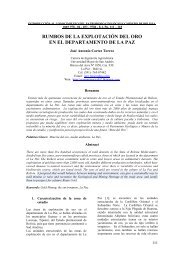Fathi Habashi - Sociedad Española para la Defensa del Patrimonio ...
Fathi Habashi - Sociedad Española para la Defensa del Patrimonio ...
Fathi Habashi - Sociedad Española para la Defensa del Patrimonio ...
Create successful ePaper yourself
Turn your PDF publications into a flip-book with our unique Google optimized e-Paper software.
96<br />
Figure 3. Iron production in Roman times. Note the foot-operated bellows and the charcoal kiln at the left.<br />
Figure 4. Manually-operated bellows (Biringuccio, 1540).<br />
Figure 5. Water wheel operating bellows (Agrico<strong>la</strong>, 1555).<br />
A new invention appeared in the Middle Ages when it<br />
was found that the system of water wheel and bellow<br />
can be rep<strong>la</strong>ced by a simple device known as trompe, or<br />
hydraulic air b<strong>la</strong>st, that did not need a moving part (Figure<br />
6 and 7). This device was first described in 1589 by<br />
De Re Metallica 13 julio–diciembre 2009 2ª época<br />
the Neapolitan scho<strong>la</strong>r Giambattista <strong>del</strong><strong>la</strong> Porta (1535-<br />
1615 ) (Figure 8) in his Magiæ Naturalis libri XX (English<br />
trans<strong>la</strong>tion London, 1658). This new system was introduced<br />
on <strong>la</strong>rge scale in the vil<strong>la</strong>ge of Ripoll, province of<br />
Gerona in Catalonia, Kingdom of Aragon in Spain around<br />
Figure 6. Principle of the trompe.
















